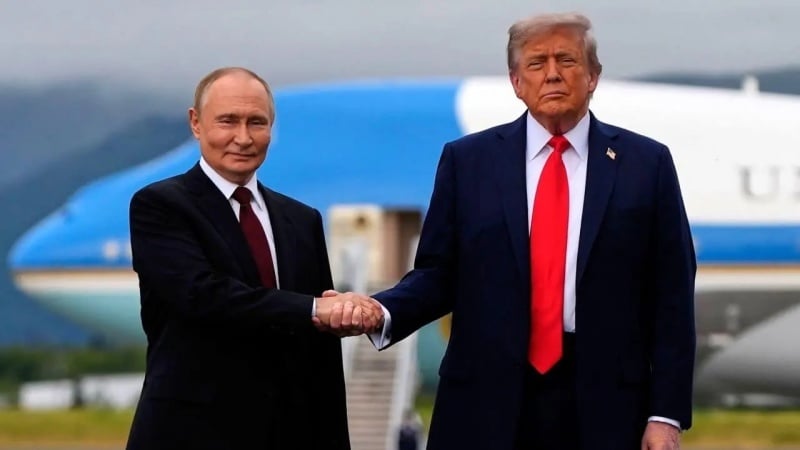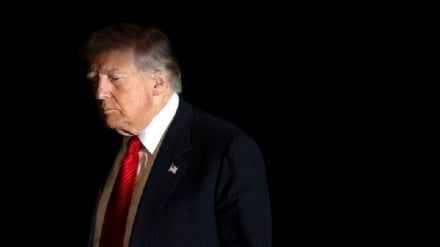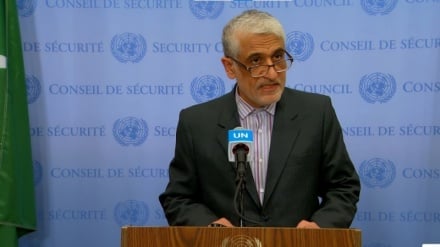What was outcome of controversial Trump–Putin meeting in Alaska?
-

Trump–Putin meeting in Alaska
Pars Today – After a long period of anticipation and speculation about the meeting between U.S. President Donald Trump and Russian President Vladimir Putin regarding the war in Ukraine, the meeting was finally held on Friday, August 15, in Alaska.
According to Pars Today, following the nearly three-hour meeting between the American and Russian presidents—which was accompanied by much controversy, including the flight of American fighter jets and a B-2 bomber during Trump’s reception of Putin—the two leaders participated in a press conference.
After his meeting with Vladimir Putin, Donald Trump announced that the meeting had been constructive and that the two sides had reached agreement on many points. Trump said that in his bilateral meeting with the Russian president, “great progress” had been made, “many points have been agreed upon,” and only “very few points” remained unresolved. The U.S. president added that they have a “very good chance” for further progress.
Russian President Vladimir Putin also described the approximately three-hour talks with his American counterpart in Alaska as constructive and useful, stating that the settlement of the Ukraine conflict was one of the main issues discussed during the meeting with Trump. Putin, emphasizing Russia’s interest in ending the Ukraine crisis, expressed Moscow’s readiness to cooperate on Ukraine’s security.
The Russian president also stated: “We expect Kyiv and European capitals to understand all of this constructively, to create no obstacles, and not to make any efforts—through provocations or behind-the-scenes schemes—that would disrupt the progress achieved.”
Apparently, following this meeting, Putin invited Trump to a subsequent session in Moscow, although Trump has conditioned the holding of that meeting on further evaluations and future circumstances.
It seems that for Trump—who, since the beginning of his presidency, repeatedly claimed that he would end the war in Ukraine in a single day but faced major failure in this regard—the meeting with Putin in Alaska represented a turning point and a potential pathway to fulfilling his promise. For this reason, Trump had explicitly stated before the meeting that he would leave if it did not proceed as he expected. However, after the three-hour meeting with Putin, Trump apparently appeared satisfied.
On the other hand, the meeting also brought many achievements for Putin. First, despite the outstanding international arrest warrant issued against him by the International Criminal Court, he traveled to the United States—an act that effectively amounts to Washington’s practical recognition of his position and authority.
Additionally, the U.S. has postponed certain sanctions against Russia and intends to lift others, which constitutes another success for Moscow.
More importantly, evidence suggests that Trump intends to facilitate a ceasefire in the Ukraine war and peace between Russia and Ukraine by granting Russia control over certain Ukrainian territories—particularly the Donbas region, consisting of Luhansk and Donetsk. This would certainly represent a severe blow to Kyiv after a four-year war.
Meanwhile, media outlets and some Western politicians have generally taken a critical view of the meeting between the U.S. and Russian leaders, using headlines such as “Trump Welcomes Putin with a Red Carpet” or accusing him of flattering Putin.
In this context, John Bolton, former U.S. National Security Advisor, emphasized in reaction to the Trump–Putin summit that Vladimir Putin was the clear winner of the meeting. Some Western media, including Sky News, described the summit as humiliating for Trump. The New York Times reported that Trump provided an unclear but generally positive assessment of the progress made. Meanwhile, the Spanish newspaper El País described the summit as successful, although neither side mentioned ending the war in Ukraine.
Before the meeting, Trump had responded strongly to analysts’ comments about the potential outcomes and outlook of his upcoming meeting with Putin in Alaska—comments suggesting that the meeting could favor Russia. He criticized the media and figures such as his former National Security Advisor John Bolton, accusing them of obstructionism.
An important issue in this context is the perspective of Ukraine and European countries regarding the summit. As expected, Ukrainian President Volodymyr Zelensky strongly criticized the meeting and its outcomes. According to Zelensky, Vladimir Putin attended the meeting with three specific objectives—and achieved all of them.
When asked what Putin would gain from the meeting with Trump, Zelensky said: “Putin only needed a photo of the meeting with Trump; that image alone was enough for him to gain politically.” He further noted that, since Putin has been accused by the International Criminal Court of war crimes against Ukraine, the Russian president’s participation in the summit itself constitutes a personal victory for him.
Zelensky also emphasized that Putin sought to break out of isolation and gain international legitimacy, and the meeting with the U.S. president provided him with that opportunity. The Ukrainian president further noted, referring to Trump’s threats of imposing severe sanctions on Russia and its oil buyers, that Putin was able, through this meeting, to delay the implementation of those sanctions—sanctions that are very serious and whose enforcement Ukraine has been eagerly anticipating.
Prior to the Alaska summit between the U.S. and Russian presidents, European leaders, together with Zelensky, held a videoconference with Trump to demand guarantees for the interests of both Europe and Ukraine in the negotiations.
Among them, German Chancellor Friedrich Merz said after the videoconference that European leaders had asked Trump to ensure the security of Europe and Ukraine during the negotiations with Putin. Ursula von der Leyen, President of the European Commission, described the video call with Trump as very positive and wrote on X: “In today’s meeting, Europe, the U.S., and NATO reinforced their common stance regarding Ukraine. We will remain in close coordination.”
French President Emmanuel Macron also told reporters after the videoconference that “only Zelensky can negotiate a territorial agreement with Russia to end the war.”
The potential impacts of the Trump–Putin meeting on the Ukraine war can be summarized as follows:
- Increased pressure for a ceasefire from the U.S.: During the meeting, Trump called for an immediate halt to the war and proposed a trilateral summit with Zelensky. This stance could increase international pressure on Russia and Ukraine to enter negotiations.
- Shift in U.S. policy: The U.S. approach to Ukraine may likely shift from extensive military support to a focus on negotiation and agreement, a change that could affect the balance of power on the battlefield.
- Efforts toward a territorial agreement: It was reported that the meeting included discussions about areas under Russian control in Ukraine, though no agreement was reached. Such negotiations could pave the way for an arrangement in which parts of Ukrainian territory are ceded to Russia, which would likely trigger strong reactions from Europe and Ukraine.
- Increased tension with Europe: European countries, such as Germany and France, oppose any agreement that would lead to border changes. If the U.S. moves toward an agreement with Russia, it could create rifts within the Western alliance against Russia.
Overall, the Trump–Putin meeting in Alaska was more of a “restart” in U.S.–Russia relations than a step toward a final agreement. Putin’s body language indicated a willingness to engage, while Trump’s behavior suggested an effort to maintain control and project power.
Given the international context, this meeting could serve as a prelude to more serious negotiations in the future. While it has not had a direct or immediate impact on the Ukraine war, it serves as an important political signal that could influence the future course of events. If negotiations continue and Trump plays a mediating role, the likelihood of ending the war through a diplomatic agreement—with costs for all parties involved—would increase.


